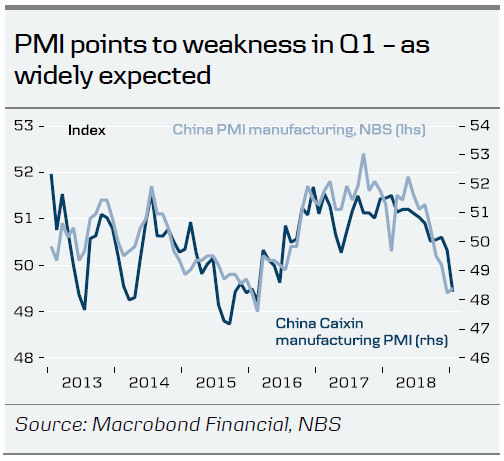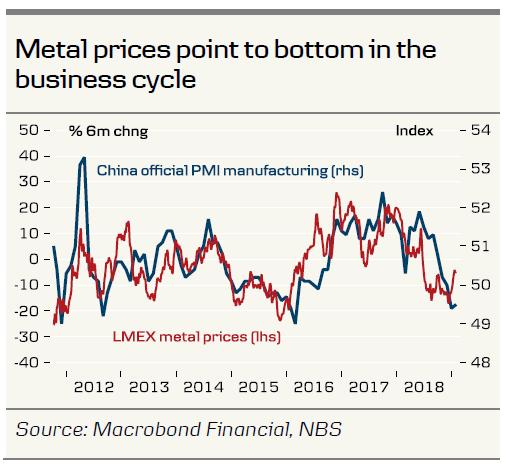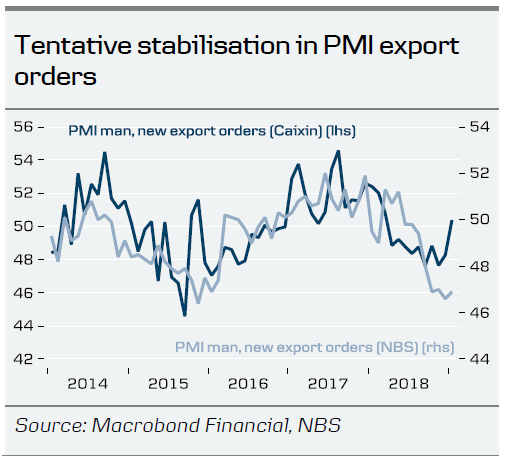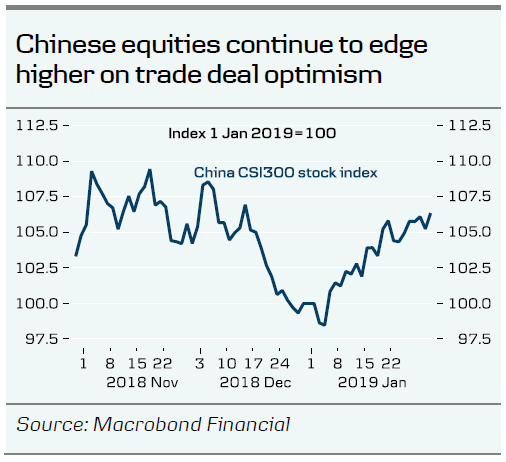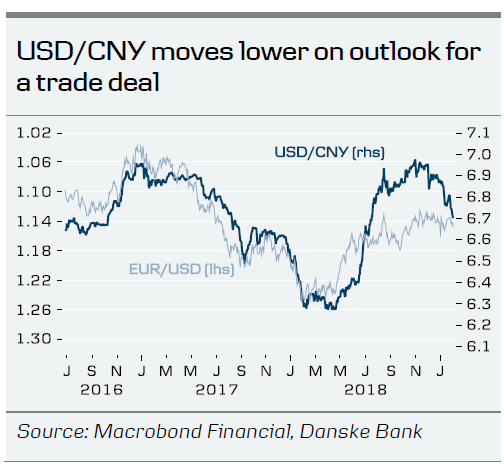- Top-level trade talks end on a positive note – a deal is in sight as soon as March
- Charges against Huawei underline tensions in tech war – how far will the US go?
- Chinese PMI points to weakness – but tentative signs of a bottom in Q1
Trade talks end on an upbeat note
The high-level trade talks in Washington this week were a litmus test of the ability of US and China to make a deal. It was time to put the tough questions on the table regarding intellectual property rights, forced technology transfer, industrial policy and non-tariff barriers. However, the meeting ended with very positive statements from both sides, see US-China trade: A deal in sight – look out for Xi-Trump meeting(s), 1 February, for more details. The US Trade Representative Robert Lighthizer and Treasury Secretary Stephen Mnuchin are now set to go to Beijing in mid-February for talks and Trump has said that the last difficult questions will be resolved by Trump and Xi at a meeting in ‘the near future’.
The tone in an oval office meeting between Trump and the US and China trade teams was cordial. Trump described a letter from Xi Jinping which was read out as ‘beautiful’. Trump said there had been ‘tremendous progress’ and it ‘will be the biggest deal ever made’. Robert Lighthizer emphasized ‘enforcement, enforcement, enforcement’ in his comment at the meeting but also pointed to progress in the talks. Fox News published a video on 31 January.
Adding to the positive picture this week, China is fast tracking a new foreign investment law that among other things will ban the transfer of technology and improve protection of intellectual property rights, see Xinhua 29 January and Reuters 30 January.
Comment. We are getting more confident that we are closer to a deal and that the probability of a deal in March has increased. The intense efforts put into the talks at the highest level – including from Trump and Xi – suggest that both sides are very keen to get the work done. It will give China more breathing space in tackling its debt challenges and Trump can present himself as the great deal maker to the American population going into the 2020 election campaign with a package that will benefit key voters in swing states. At the meeting in the oval office, Trump emphasised several times the large amount of soybeans that China will now buy and how it would benefit the farmers.
US taking a tough stance on Huawei – how far will it go?
While the prospect of an end to the trade war has improved, the tech war is nowhere near an end. This week the US raised the stakes by filing charges against Huawei and formally requesting extradition of Huawei’s CFO Meng Wengzhou from Canada.
The prosecution against Huawei concern two areas: 1) committing bank fraud by violating US sanctions against Iran and 2) stealing trade secrets from an American rival (T-Mobile US Inc.) in a case that goes back to 2014, see Bloomberg28 January. Huawei has denied the allegations of bank fraud and stated that the dispute with T-mobile US Inc. was settled in 2017, see Geekwire, 17 May 2017, for more on the settlement. The US indictment revealed that the FBI interviewed the Huawei founder Ren Zhengfei in 2007 about the company’s dealings with Iran. According to the indictment Ren Zhengfei identified as Individual-1 ‘falsely stated’ to the FBI that Huawei had not dealt directly with any Iranian company. It suggests even Ren could be charged as well, see Washington Post, 29 January. The US charges also concern a claim that Huawei offered bonuses to employees who stole confidential information from other firms.
A spokesman for China’s Ministry of Industry and Information Technology said that the US had no proof to back up the charges and called them ‘unfair and immoral’. China’s Foreign Ministry said in a statement that Beijing would resolutely protect the interests of Chinese companies.
Comment. Trade deal or not, it is clear the tech war will rage on. Some US politicians have argued for a ban of selling microchips to Huawei, which could cause severe disruption for Huawei in the short term. However, a step like that would in our view quickly back-fire and possibly trigger a consumer boycott of US goods in China. For more on Huawei and the tech war see this article in Foreign Affairs: Is Huawei a pawn in the trade war? 30 January.
Chinese PMI data weak – but rays of light hint at bottom soon
Both the private and official version of PMI manufacturing was released this week. The PMI is one of our favourite gauges of the state of the Chinese business cycle. The official version surprised a bit to the upside whereas the private version declined sharply. Some may say this is a sign that the official data are unreliable. However, it is actually the case that the official version has dropped much more in previous months and the private version is simply catching up with this weakness (see top chart on page 1). On a positive note, the export orders in both sets of PMI point to stabilisation/bottom and the same picture emerges when looking at metal prices, which are normally a good real-time indicator for Chinese activity (China consumes 50% of global metals).
China announced further stimulus for consumers this week offering subsidies on cars and home appliances, see Reuters 29 January. There were no details, though, and it is unclear how significant it is. We still await an announcement on further tax cuts.
Comment. We still look for a bottom in the Chinese business cycle in Q1 followed by a moderate recovery. The drivers should be a US-China trade deal and Chinese stimulus.
Other news of the week
Huawei is set to unveil a 5G foldable smartphone, see People’s Daily 26 January.
In a Senate hearing, US intelligence chiefs stated that China and Russia pose the biggest threat to the US and are more aligned than they have been in decades, see Reuters 29 January.
China continues to send warnings to Taiwan. In a China Daily Editorial it said ‘nationhood’ talk only leads it to abyss. On Saturday China called on the US to abide by the one-China policy after US warships sailed through the Taiwan Strait, see People’s Daily 26 January. It was the fourth such ‘Freedom of Navigation’ since summer.
China released footage of the so-called ‘Guam killer’ ballistic missile for the first time on state TV amid intensified US-China military rivalry, see SCMP 28 January.
Warning to China – Germany may be about to get tough, SCMP 26 January




